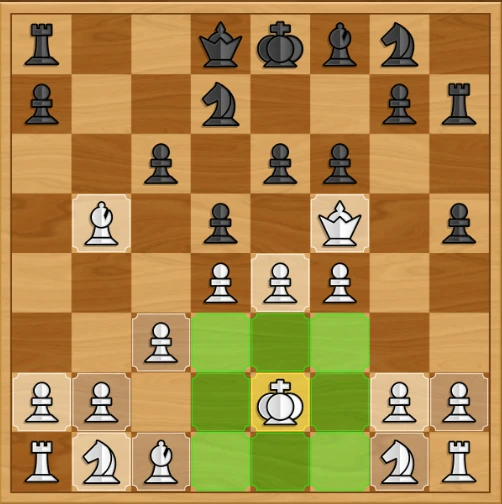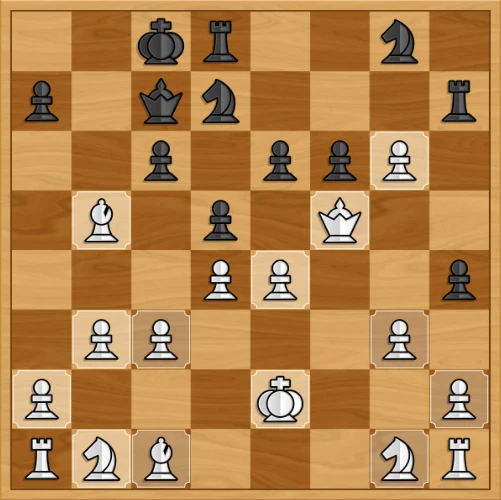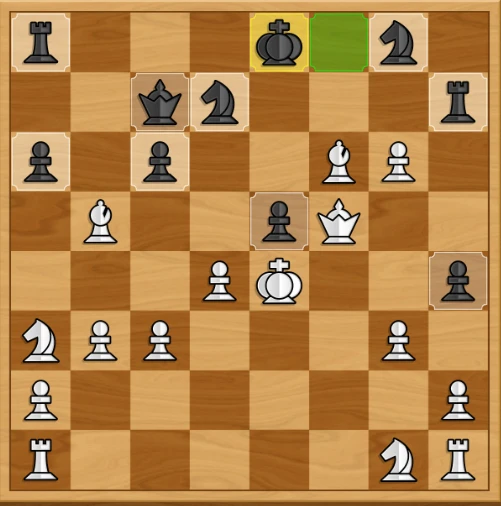Chess Strategy: What Moves Can the King Make?

The King is the most important piece on a chessboard. Your goal is to capture your opponents while ensuring they can’t capture yours. As a result, you’ll only win a game of chess if you understand what moves the King can make. This is the key to outmaneuvering your opponent and preventing a checkmate.
Introduction to the King’s Role
The King has a very simple role in chess: avoid being checkmated by your opponent. The game ends if this happens, which is why you need to move your King around the board and avoid getting trapped in perilous situations.
Ironically, the King isn’t as powerful as any other piece on the board - even the Pawns hold more power, as they can turn into other pieces by reaching the end square. While you can take other pieces with the King, it rarely comes down to this situation. Most of the time, you’re trying to hide behind your pieces and protect the King while also figuring out how to corner your opponent and secure a checkmate.
Standard Moves of a Chess King
The good thing about the King is that you don’t have a huge number of moves to remember. It’s not like moving a Knight, which requires more thought power to decide how many spaces to move them and which direction you can move depending on where they are on the board.
With the King, you can only move it as follows:
- One space in any direction

This image demonstrates all the available standard moves perfectly. You can move the King laterally, vertically, or diagonally - but it can only move one space per turn. As you may suspect, this doesn’t give it a great deal of versatility, and it means you have to plan moves many turns in advance to get your King to cover.
The King can also take any piece that’s within its movement area, as demonstrated below:

Here, the opponent’s Bishop is in front of the King and can be taken. You’ll also notice that the green spaces on either side of the King are no longer available. Why? Because moving it to either of these spaces means the Bishop can take it on the next turn, which would end the game.
Special Move: Castling Explained
You’re probably thinking that the King is quite a boring piece without any fun ways to move. However, it is one of the only chess pieces with a special move: castling. This move involves the King and one of your Rooks, and it allows both pieces to move unconventionally and defy their normal rules of engagement. It is also the only move in a game of chess where two pieces can be moved in one go.
You will need both your King and a Rook to still be on the first rank with clear spaces between them. From here, you can move the King two squares to the side and place the Rook from that side next to the King on the opposite side.
Words make it sound more confusing, so here’s a quick visual breakdown to show you what it looks like on a board:

This first image shows the perfect conditions for castling. As you can see, the King has its usual movement areas highlighted in green, plus an additional space two to the left. There are no pieces between it and the Rook on the left side of the board, meaning you can successfully play a castling move - as demonstrated below:

The King moved two spaces to the left, and the Rook transferred to its right-hand side. You could do the same thing with the Rook on the right if the conditions were met. Castling is seen as a brilliant defensive move, particularly if you have coverage from Pawns or other pieces in the second rank. It moves the Rook over to give protection from a potentially open side.
What are the rules for castling in chess? Aside from there being no pieces between the King and Rook, you need to ensure the following conditions are met:
- Neither the King nor the Rook have moved yet
- The King is not currently in check and won’t end up in check after castling
- The King will not pass through a square that an opponent’s piece can attack
The final rule is probably the most confusing, but here’s what it looks like in a game:

We’ve got the same conditions as the previous example; only the King cannot castle because it moves through a square attacked by the white Bishop. Even though it won’t end up on that square, it goes against the rules of castling to make the move.
Strategies for Protecting Your King
We’ve just spoken about it, but castling is the number one defensive move for a King. It’s great to use this early on to move your King to safety and put it behind strong defensive lines. This avoids any early checks as you pretty much eliminate any main lines of sight the opponent can get on your King from their Rooks, Bishops, or Queen.
Another great early-game strategy is to avoid moving pawns around your King. You can move the Queenside pawns to get some advancement and claim board territory, but you don’t want to leave massive gaps on the Kingside. Try to create a protective bubble around your King, which forces the opponent to be overly aggressive and remove these pawns using their pieces. When that happens, it normally means you can capture a far more valuable piece with your King before retreating behind the defensive lines.
You should also be conscious of your powerful pieces and where they’re placed. As tempting as it is to advance your Bishops and Rooks up the board, you should try to keep at least one of each near your King for some quick defensive counters. The same goes for your Queen - she can make some big advances and take a few pieces off the board, but you need to ensure she’s always ready to fall back and protect the King.
Chess is all about board coverage and owning as many spaces as possible. You’ll also have a higher chance of winning games and protecting your King if you get rid of your opponent’s pieces. As such, attack can sometimes be the best form of defense. Regardless, you should try to move as a unit. If you want to advance some pawns or pieces near your King, then plan to do so strategically so the King can move with them and stay hidden.
Common Mistakes to Avoid with Kings
We see new chess players make the same King-based mistakes all the time. So, here’s a quick rundown of what not to do so you can see more chess success:
- Not Castling Early - Yes, we’ll bang on about castling for as long as we like. A rookie error is to avoid castling or waste an opportunity to castle. You should move your King away from the center as quickly as possible. The central position is the most exposed and leaves you open to attacks from all angles, including a quick pincer move from opposing Bishops.
- Castling Into A Dangerous Position - Thankfully, the laws of castling stop you from moving your King directly into the line of attack. Despite this, many players will castle on the wrong side and put their King in more danger. Look at the board and see what your opponent is trying to do. If they’re mounting a Queenside attack, then castle Kingside. Don’t lead your King to the danger zone, as it’s hard to get out of it.
- Staying Too Passive In The Endgame - As more and more pieces leave the board, you enter what is known as the “endgame.” This is where one of you will win within a few moves, and it’s also when you have to change your strategy. Don’t stay passive with your King in the endgame; it’s time to go on the offensive and use it with pawns or other pieces to cut off your opponent's movements and secure a stranglehold on the game. If you keep your King on the first rank, then you’re asking for trouble. Move it towards the center so it’s close to the action and can make a real difference.
On that note, you’ve reached the end of our chess strategy guide and now know how Kings move across the board. Remember, protecting the King is the sole goal of chess - if you can’t do this, then your opponent will win. It requires a keen strategy that combines the right amount of defense and offense. The best way to learn is to play as much chess as possible and put yourself in different situations that require you to move your King in certain ways. Play for free at 247Chess.com to hone your skills and become a Grand Master.
Seasonal Chess Games
More Games
Chess News
Disclaimer
DISCLAIMER: The games on this website are using PLAY (fake) money. No payouts will be awarded, there are no "winnings", as all games represented by 247 Games LLC are free to play. Play strictly for fun.

































